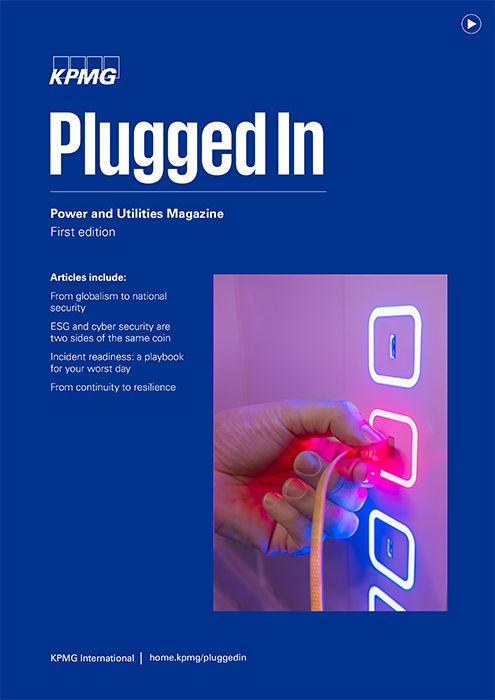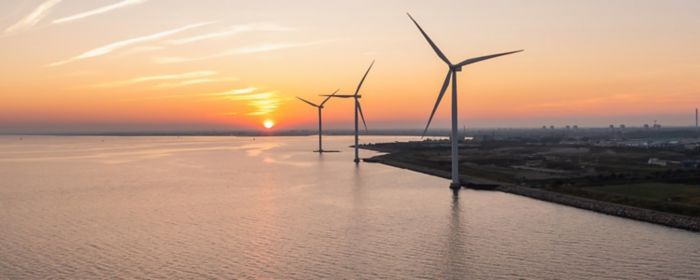The war in Ukraine has dramatically altered perceptions of energy security and accelerated many countries’ decarbonisation agenda.
Since the tanks rolled across the Ukrainian border, many power & utilities (P&U) providers had to rethink their energy supply strategies. Having become accustomed to a global market dictated primarily by price, the sector is now adjusting to the idea of sourcing energy only from countries considered political allies.
The European Union (EU) has pledged to cut its gas supply from Russia by two-thirds by the end of 2022, agreed on a partial ban on Russian oil1 and announced a deal to buy an additional 15 billion cubic liters of LNG (liquified natural gas) from the US to reduce its dependence on Russian energy.2 In a way, geopolitical imperatives are now pushing the EU to dramatically accelerate its net zero ambition, as exemplified by its RePower EU plan.3 Even regions less reliant on Russian imports to power their economies will still feel the effect of global energy price volatility in the wake of supply dislocation, western sanctions, as well as self-sanctioning by companies who are wary of reputational damage., a stark reminder of the importance of stable, resilient energy supply chains.
In addition to seeking new conventional energy suppliers, governments, especially in Europe, will be pushing for greater energy efficiency, accelerating the transition to renewables, and investing in nuclear power.
The P&U sector was already undergoing huge disruption before the war, with society’s shift to all things electric, the green energy revolution reshaping grids, and digitalization shaking up ways of working. Add to this evolving geopolitical, supply chain, environmental, investment, cyber, talent, and cost risks, and companies must cope with an uncertain future.
Geopolitical/supply chain risk: rewriting the global energy map
One consequence of the decoupling from Russian energy could be the division of the world into new energy blocs of countries broadly sympathetic to each other — such as the Atlantic (the US and Europe), China, India and Russia, with the Gulf and other non-aligned countries possibly supplying both blocs (unless secondary sanctions become an option).
Such a move would radically change global supply chains as P&U providers look for immediate alternative sources, including LNG from the US and other regions, to satisfy domestic demand from consumers and energy-intensive industries like steel, manufacturing and chemicals.

COVID-19 had already exposed vulnerabilities of globally interdependent supply chains as P&U players struggled to access critical resources throughout the pandemic. Now that Russia, Ukraine, and possibly other neighboring countries have effectively been cut out of supply chains, it’s vital to find new, reliable sources swiftly.
Those countries at an earlier stage in their energy transition face difficult choices, as they have fewer alternatives to fossil fuels and won’t want to risk blackouts or industrial disruption.
Supply chains for nuclear, hydrogen and renewable energy components, especially uranium, batteries, solar and wind power, will likely come under more significant pressure as the race for alternatives intensifies.
Action: Define the key risks to your organization’s footprint, monitor events, and plan scenarios encompassing different election results, security developments, and national ideological trends. If feasible, explore the possibility of risk-proofing supply chains by duplicating them across like-minded regional/ideological blocs to limit exposure to geopolitical uncertainty.
Investment risk: driving decarbonization
For some governments, especially in Europe, the shock of reducing dependence on Russian gas and, to a lesser extent, oil has made them even more determined to decarbonize their economies. The EU’s ‘Fit for 55’ proposals (to cut greenhouse gas emissions by 55 percent by 2030) continues to be a significant driver of investment. China has committed to reducing its carbon footprint, with the subsequent associated costs in the short term..
The US also has ambitious clean energy plans. However, with its abundant shale gas and oil supplies, it will remain a fossil fuel player to meet domestic consumption and satisfy global demand. Australia has been relatively unaffected by events in Europe and has rich seams of coal, gas and other natural resources. But it also has a solid green agenda, with many solar and wind projects in progress. Almost one-third of Australia’s electricity in 2021 came from renewable sources — a 5 percent increase on the previous year.4
Action: At an industry level, P&U providers should work towards their organizational decarbonization targets, cut emissions, and carry out robust ESG reporting to demonstrate that they’re on track. Regulated businesses should align their goals with the latest regulations or alternatively seek approval when there is ambiguity, if regulations allow so (which is the case in certain jurisdictions). For companies operating in non-regulated segments or where direct regulatory cover is not available, the appropriate approach is to look for financing instruments that explicitly cater to their circumstances. Transition financing is receiving a lot of attention, with regulatory authorities and financiers explicitly addressing transition needs and taking on board associated risks. In this way, they can gain a degree of cover for their investment risks.
Net zero targets place considerable pressure on governments and private P&U operators to invest in carbon-free technologies. It’s a similar story with the anticipated renaissance of nuclear, which is expected to play a more prominent role in the energy mix. Establishing secure energy capabilities requires a wide range of capital-intensive infrastructure to achieve electrification of transport and other parts of the economy. These efforts are primarily on a country-by-country basis rather than collective, cross-border initiatives, with different nations traveling at varying speeds.
The huge investment required to achieve net-zero may strain economies only starting to emerge from a pandemic-induced recession.

Cyber risk: growing threats across a vast attack surface
P&U assets are increasingly recognized as vital to national security. Given the sanctions and other actions taken against Russia, and the support for Ukraine, the threat of retaliation is exceptionally high in the form of hacking, ransomware, and malware. This is on top of other nation-state actors, cybercriminals and hacktivists. The geographical scale and complexity of P&U organizations mean that attack surfaces are broad, with the risk of putting power plants, generators and wind turbines out of action; remotely disconnecting grids to halt transmission and distribution to customers; and attacks on IoT, devices and electric vehicles, leading to the theft of customer information, billing fraud and disrupted services.
Action: To be fully prepared, P&U providers should review their business continuity plans, assess the vulnerabilities along the supply chain, and conduct exercises for recovering after a breach. Building a cyber-aware culture will help avoid the prospect of an attack and improve incident reporting. And with growing regulatory expectations, formal monitoring and reporting have become a high priority. Given the potential for nation-state attacks, the P&U industry as a whole must work with the government to tighten defenses and improve the capability to respond.
Distribution risk: meeting evolving customer demands
The topology of power generation is changing with a transition to a more distributed, decentralized grid, with many new players — often able to generate their own (renewable) electricity and sell it to others. All of which shifts power to consumers and threatens P&U revenue streams, as customers find it easier to switch suppliers or even produce power themselves — aided by rapid digitization. Network management grows in complexity, and P&U companies must ensure they balance energy supplies from the many providers to avoid suffering reputational damage.
Action: It’s vital to build resilience into the grid through more effective scenario planning to predict demand and plan accordingly to avoid outages. P&U companies should work closely with other grid stakeholders and build redundancy into the system so that one failure doesn’t bring down the whole network.
Climate change risk: maintaining assets
Wildfires, in particular, pose a substantial risk to P&U providers. With thousands of kilometers of gas pipelines and electric power lines, a minor fault in equipment can quickly spark off a new fire. Companies can suffer hefty fines — and convictions for manslaughter — if they’re found to have involuntarily started wildfires by failing to maintain infrastructure adequately.
Climate change has brutally exposed aging infrastructure and puts pressure to preserve and replace assets and trim back surrounding vegetation. Assets are also highly vulnerable to other impacts of climate change, such as floods, winds and freezing weather, increasing in frequency and intensity.
The increasing occurrence of severe weather events places a growing insurance risk, pushing up premiums to a point where they impact margins. All the more reason to improve defenses.
Action: Tools to help achieve greater resilience include risk models to detect the most at-risk infrastructure, visual and aerial inspections, vegetation management, monitoring cameras, satellite technology, and separating the grid into smaller sections to minimize damage. Proactive power shut-offs are the last resort, turning off electricity when winds and dry conditions increase fire risk. And, of course, P&U companies should invest in assets to help ensure they’re robust enough to cope with modern-day pressures.

Talent risk: appealing to a new generation of workers
Like many sectors, P&U organizations face competition for people, exacerbated in some parts of the world by the great resignation accompanying the pandemic. Turnover in P&U was already relatively high compared to other industries, made more urgent by an aging workforce approaching retirement.
Younger employees are more likely to want fulfilling experiences that give them opportunities to grow. Roles and careers need to evolve to meet these expectations, including increased use of technology and less top-down management. And providers will likely be under increasing pressure to show that they are building diverse workplaces.
Action: Attempts should be made to improve the industry’s attractiveness to new candidates and retain existing workers, moving away from hierarchical structures and encouraging innovation. Hybrid working can help with these efforts, to create the kind of flexibility that workers of all generations are looking for. As the digital revolution gathers pace, cultural and organizational change will be necessary to create an environment that encourages innovation in decarbonization and distribution.
Many of today’s younger workers are driven by a new-age purpose to improve society and the environment. P&U organizations whose values and strategies align with these principles are likely to be more attractive to this new generation. In addition, fewer plan long careers in one organization, so a higher churn may become the norm and something that companies must plan for. It will be important to build a critical mass of capabilities in core functions that are managed internally to cope with higher employee turnover. For non-core or thinly staffed operations, or in areas where it’s hard to recruit and retain specific, in-demand skills, the use of outsourced/gig economy workers may be necessary, especially from agencies with a bench strength of specialized talent.
Cost risk: Coping with volatility
Oil and gas prices, already high since the COVID-19 recovery, have soared since the conflict in Ukraine began. Governments may come under pressure to subsidize energy, fearing that inflation could provoke civil unrest. The cost of power generation has risen in line with commodity, oil, and gas costs.

Some of these increases can be passed onto businesses and consumers in a regulated sector, but there is often a cap, which inevitably hits profitability. Coping with such volatility is challenging, and sourcing alternatives like LNG or shifting to renewables cannot happen overnight.
P&U providers will be assessing how they can improve operational efficiency and productivity to avoid having to pass on too much of the higher input costs to customers.
Action: Governments, regulators and providers can foster more significant energy efficiency, working with investors, regulators, power companies, and the wider business community to help incubate new startups and change consumer and business habits.
Towards a resilient future
Energy transformation and energy security are increasingly seen as complementary goals. As P&U providers plan a resilient future, they must gain more reliability over the supply of traditional fossil fuels while securing the investment in renewables — and possibly nuclear — to achieve a level of diversity that will make them more self-sufficient.
The war in Ukraine has demonstrated how quickly situations can change. Add cyber threats and climate-related risks into the mix, and there’s even more reason to establish strong resilience and incident response planning to keep vital national assets operating in a volatile world.
Much of what may happen is out of the control of the P&U industry. However, here are some steps to help your organization be as well-positioned and prepared as possible regardless of what occurs in 2022 and beyond:
Prepare a plan to manage activist investors and other stakeholders, who increasingly use ESG (environmental, social and governance) issues to open the door.
Review your organization’s crisis playbook. Does it include all potential scenarios, and is it updated regularly?
Review your organization’s commodity risk management philosophy. Prepare for how short and long-term changes in the pricing environment could impact customer and shareholder sentiment and government involvement.
Understand how proposed legislation and government actions could affect your company: does your organization have the flexibility to shift gears quickly to take advantage of opportunities as political agendas change?
Focus on relationship building: continue or increase efforts to build relationships with all relevant stakeholders, including consumer groups, governments, regulators, and society. In the same way, consider industry and cross-industry cooperation efforts to proactively shape reasonable regulation with governments.
Get your supply chins in order: review your current setup and determine how you can reduce disruption and improve resilience.
Review your organization’s cyber defense protection: the risk of a cyber breach is perhaps the most underestimated above-ground risk in the P&U sector. It cuts across political and geographical risks, and any company, regardless of size, is a potential target. You are vulnerable to a cyber security breach no matter where you operate.
Contact us
Explore
1 Bruegel, Europe’s Russian oil embargo: significant but not yet, June 2022.
2 BBC, EU signs US gas deal to curb reliance on Russia, March 2022.
3 European Comission, REPowerEU: A plan to rapidly reduce dependence on Russian fossil fuels and fast forward the green transition, May 2022.
4 Clean Energy Council, Clean Energy Australia Report, April 2022




